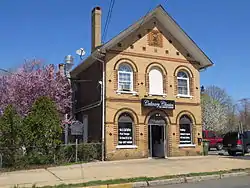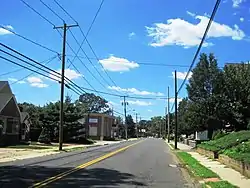There are numerous historical and contemporary neighborhoods in Sayreville, a borough in Middlesex County, New Jersey, United States.[1][2][3][4][5][6]
Sayreville has a total area of 18.704 square miles (48.442 km2), of which 15.842 square miles (41.030 km2) was land and 2.862 square miles (7.412 km2) was water (15.30%).[7] It is located on a peninsula shared with South Amboy, created by the Raritan River at the north, its tributary South River to the west, and the Raritan Bay to the east.[8] The original village of Sayreville has been known as Sayre's Village, Upper Sayreville, and Sayreville Proper.

Sayreville was originally settled by Europeans in the colonial era and was part the South Amboy Township formed in 1684. It seceded and incorporated as a township on April 6, 1876. The newly formed Township of Sayreville was created out of approximately 14 square miles of south of today's South Amboy consolidating the settlements at Morgan, Melrose, Ernston, and Sayre's Village under one municipal government. The area around the village was then known as Wood's Landing was renamed Sayreville after Sayre and Fisher Brick Company. Fewer than 2,000 people resided in the new township. Several areas take their name from stations along the Raritan River Railroad.
Sayreville developed into an industrial town in the late 19th century when most of the land was owned numerous clay, sand, and brick companies such the Such Clay Company, the Furman Brick Company, the Crossman Sand & Clay Company, Whitehead Brothers, and the Sayre & Fisher Brick Company, once the largest brickworks in the world. With the coming of other industries at the turn of the century such as DuPont, Hercules, and National Lead, Sayreville promoted itself as the “Home of Nationally Known Industries.” On April 2, 1919, the township was reincorporated as the Borough of Sayreville and ratified by a referendum held on April 29, 1919.[9]
According to Joseph T. Karcher, an attorney, who wrote the post-war promotional The case for Sayreville, Middlesex County, New Jersey in 1947, the borough had seven residential districts, which were separated by the large industrial complexes throughout the borough.[10] After World War II, with the sale of former clay land holdings to housing developers. President Park, a suburban subdivision, was built just after the war.[11] Sayreville's population grew from 8,000 in 1945 to over 32,000 by 1970.
Much of Sayreville's housing was built in the 1940s, 1950s, and 1960s.[12] In the 1950s many clay companies sold their land holdings and gave way new housing “developments”.[13] The largest, Laurel Park, became home to over 500 families. Other projects included Pershing Park, Deerfield Estates, Hope Homes, Parkway Homes, and Haven Village. In the 1960s more housing developments such as Woodside, Sayre Woods, and Oak Tree East and West were built.[14] In 1970s and 80s Sayreville transitioned from an industrial community to a suburb as its once vibrant industrial landscape gave way to housing developments, and as more residents commute to jobs outside of town it became more of bedroom community. By the 2000s, Sayreville's population surpassed 40,000 as brownfield land saw more housing construction.
List of sections and neighborhoods
See also
References
- 1 2 Gannett, Henry (January 28, 1895). "A Geographic Dictionary of New Jersey". U.S. Government Printing Office – via Google Books.
- 1 2 3 4 "NJDOT Graphic Information System Maps Middlesex" (PDF). New Jersey Department of Transportation. Retrieved April 23, 2020.
- 1 2 3 4 "Sanitation Division - Borough of Sayreville". www.sayreville.com.
- 1 2 3 4 "Grass Collection - Borough of Sayreville". www.sayreville.com.
- 1 2 3 4 "Locality Search". State of New Jersey. Retrieved April 25, 2020.
- ↑ "Home". Archived from the original on 2020-04-14. Retrieved 2020-04-30.
- ↑ 2010 Census Gazetteer Files: New Jersey County Subdivisions, United States Census Bureau. Accessed April 27, 2020.
- ↑ Slesinski, Jason J. (August 18, 2014). Along the Raritan River: South Amboy to New Brunswick. Arcadia Publishing. ISBN 9781439646762 – via Google Books.
- ↑ Snyder, John P. The Story of New Jersey's Civil Boundaries: 1606-1968, Bureau of Geology and Topography; Trenton, New Jersey; 1969. p. 173. Accessed May 8, 2012.
- ↑ Karcher, Joseph T. (1947). "The case for Sayreville, Middlesex County, New Jersey".http://www.sayrevillehistory.org/#!seven-sections/ch7s
- 1 2 3 Cheslow, Jerry (August 16, 1992). "If You're Thinking of Living in Sayreville". The New York Times. Retrieved April 27, 2020.
- ↑ Cheslow, Jerry (November 7, 2004). "As Manufacturing Fades, Commuters Fill the Gap". The New York Times. Retrieved 2 June 2015.
The oldest neighborhood is Tangletown, off Main Street, where narrow two- and three-bedroom colonials built for factory workers a century ago are tightly packed along narrow, crooked lanes. Nearly half of the borough's approximately 15,500 housing units were built from 1940 to 1969.
- 1 2 3 Cappuzzo, Jill P. (January 2, 2011). "Long on Space, Water and Industry". The New York Times. Retrieved 2 June 2015.
- ↑ "Sayreville Historical Society". Retrieved 2 June 2015.
1947: The postwar housing boom begins as borough attorney Joseph Karcher actively promotes the benefits of Sayreville, proclaiming that "the people prosper where industry prospers." With breakneck speed, the vast tracts of industrial land that separate Sayreville's seven neighborhoods are sold to housing developers. As America quickly became a suburban nation, for the first time, Sayreville's land itself became more valuable than the clay within...1950s: A great number of new housing "developments" are built throughout the sprawling borough as clay companies sell their land holdings, which had depreciated in value with the growing housing boom. Laurel Park, the largest of these developments, becomes home to over 500 families. Other new housing projects include Pershing Park, President Park, Deerfield Estates, Hope Homes, Parkway Homes, and Haven Village....1960s: More housing developments, such as Woodside, Sayre Woods, and Oak Tree East and West, raise Sayreville's population to 32,508 by the end of the decade.
- ↑ "ZIP Code Lookup". United States Postal Service. 2009. Retrieved May 2, 2009.
- 1 2 "Crossmans & Melrose Sayreville, NJ 08872, Neighborhood Profile - NeighborhoodScout". www.neighborhoodscout.com.
- ↑ Haydon, Tom (August 1, 2010). "Historic railroad to be preserved as Sayreville widens nearby intersection". nj.com. Retrieved 27 March 2020.
- ↑ "A Timeline of Sayreville History". Sayreville Historical Society. Archived from the original on 25 December 2019. Retrieved 27 March 2020.
- ↑ "Kaplan Companies opens final phase of La Mer in Sayreville". MY CENTRAL JERSEY.
- ↑ "Sayreville street braces for Sandy buyouts". 30 June 2013.
- ↑ "FACT SHEET - South River, Raritan Basin, NJ".
- ↑ http://www.sayreville.com/documents/PRESENTATION%20FOR%20INTERNET.pdf. Archived 2016-04-08 at the Wayback Machine
- ↑ "MacArthur Manor". Geographic Names Information System. United States Geological Survey, United States Department of the Interior.
- ↑ Gabrielan, Randall (2012). Explosion at Morgan: The World War I Middlesex Munitions Disaster. The History Press. ISBN 9781609495176. Archived from the original on 2016-03-24.
- ↑ "Morgan". Geographic Names Information System. United States Geological Survey, United States Department of the Interior.
- ↑ "There's No Easy Way Out for Sandy Survivors Looking to Move On with Their Lives". NJ Spotlight. August 7, 2013.
- ↑ http://sub.gmnews.com/news/2012-12-27/Front_Page/Legislators_survey_flood_damage_in_Sayreville.html Archived 2013-04-11 at archive.today
- ↑ "Parlin Sayreville, NJ 08872, Neighborhood Profile - NeighborhoodScout". www.neighborhoodscout.com.
- ↑ "History of the Raritan River Railroad". www.raritanriver-rr.com.
- ↑ "Phoenix". Geographic Names Information System. United States Geological Survey, United States Department of the Interior.
- ↑ Society, Sayreville Historical (April 25, 2001). Sayreville. Arcadia Publishing. ISBN 9780738504902 – via Google Books.
- ↑ Slesinski, James J. (2014), Along the Raritan River: South Amboy to New Brunswick, Images of America Arcadia Publishing, ISBN 9781467121545
- ↑ Martin, Antoinette (February 5, 2006). "Competing Plans to Transform a Town". The New York Times.
- ↑ Morris, Sebastian (January 4, 2020). "City Officials Approve $2.5 Billion Waterfront Development in Sayreville, New Jersey".
- ↑ Perry, Jessica (2015-03-12). "Millennial marketplace In Sayreville, Luxury Point aspires to be mall of the next generation". NJBIZ. Retrieved 2020-04-27.
- ↑ Loyer, Susan. "$2.5 billion waterfront project will create town within a town in Sayreville". MY CENTRAL JERSEY.
- ↑ Hurdle, Jon (8 March 2016). "A Project Reclaims an Abandoned Stretch of New Jersey Coast". The New York Times.
- ↑ "$2.5B, 418-acre Sayreville development to be announced". 13 November 2017.
- ↑ Perry, Jessica (2014-05-26). "Coming soon Sayreville's mall for millennials". NJBIZ. Retrieved 2020-04-27.
- ↑ "Sayreville Junction". Geographic Names Information System. United States Geological Survey, United States Department of the Interior.
- ↑ "Sayreville Station". Geographic Names Information System. United States Geological Survey, United States Department of the Interior.
- ↑ "Tangletown - Sayreville, New Jersey". Neighborhoods.com. Retrieved 2020-04-27.
- ↑ Star-Ledger, Aliyah Shahid/For The (February 17, 2010). "Sayreville reaches settlement on security with apartment complex owner". nj.

_at_Middlesex_County_Route_675_(Jernee_Mill_Road)_and_MacArthur_Avenue_in_Sayreville%252C_Middlesex_County%252C_New_Jersey.jpg.webp)



.jpg.webp)
